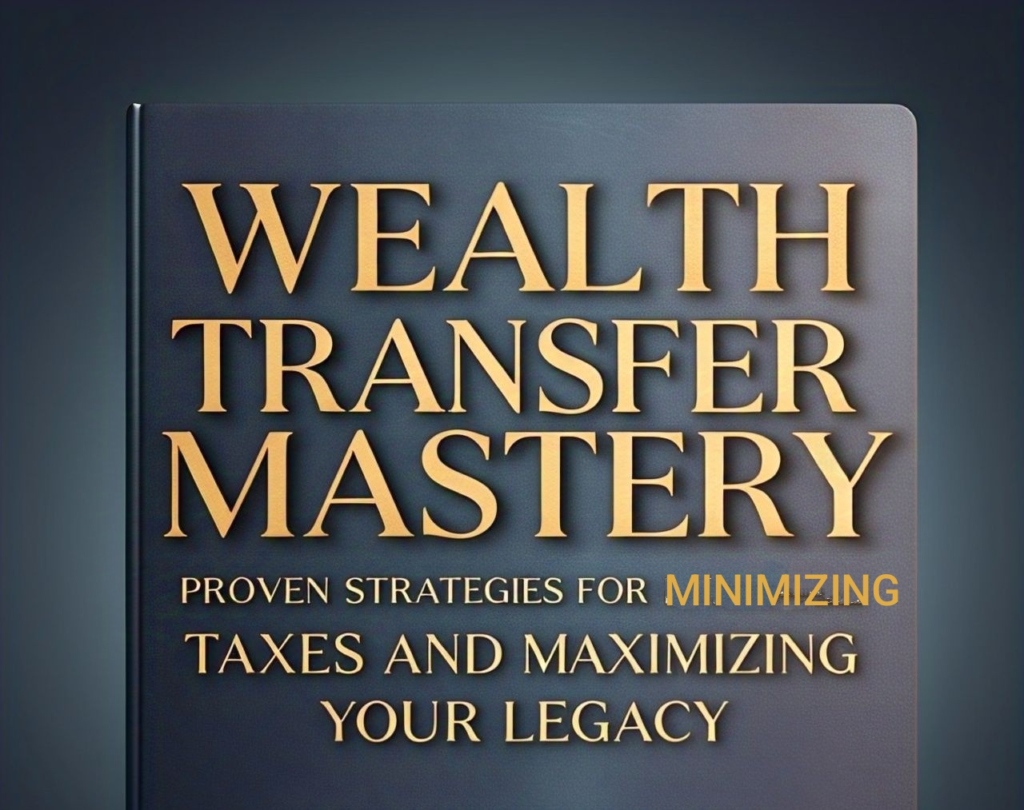WEALTH TRANSFER MASTERY: 6 PROVEN STRATEGIES FOR MINIMIZING TAXES AND MAXIMIZING YOUR LEGACY
This comprehensive guide reveals proven strategies for effectively transferring wealth to future generations while minimizing tax burdens. Learn how to structure your estate plan to protect your assets, reduce estate taxes, and create a lasting legacy. Discover key wealth transfer strategies, including trusts, gifting, and tax-efficient investment planning, designed to help you preserve your wealth and maximize the inheritance you pass down to your heirs. Whether you’re focused on estate tax reduction, generational wealth building, or protecting your family’s financial future, these strategies will empower you to master the art of wealth transfer.
UNDERSTANDING THE CHALLENGES OF WEALTH TRANSFER

Wealth transfer can be a complex and emotional process, involving multiple stakeholders and requiring careful planning. Some of the most significant challenges individuals face when transferring wealth include:
Taxation Challenges
1. Minimizing taxes: Canada has a complex tax system, with various taxes and fees that can erode wealth. Understanding how to minimize taxes is crucial to preserving wealth.
2. Estate taxes: Estate taxes can be significant, and failure to plan properly can result in a substantial tax burden on beneficiaries.
3. Income taxes: Income taxes can impact wealth transfer, particularly when transferring income-generating assets.
4. Capital gains taxes: Capital gains taxes can be significant when transferring assets that have appreciated in value.
Family Dynamics Challenges
1. Family conflicts: Wealth transfer can create conflicts among family members, particularly if there are differing opinions on how to manage and distribute wealth.
2. Beneficiary designations: Ensuring that beneficiary designations are up-to-date and aligned with overall estate plans can be a challenge.
3. Family governance: Establishing a governance structure to manage family wealth can be complex and require significant time and effort.
4. Communication: Effective communication among family members is crucial to ensure that everyone is aligned and aware of the wealth transfer plan.
Risk Management Challenges
1. Market volatility: Market fluctuations can impact the value of wealth transfer assets, requiring careful management and risk mitigation strategies.
2. Inflation: Inflation can erode the purchasing power of wealth transfer assets, requiring careful planning to ensure that wealth maintains its value over time.
3. Unforeseen events: Unforeseen events, such as death, disability, or divorce, can impact wealth transfer plans, requiring careful contingency planning.
4. Cybersecurity: Cybersecurity risks can impact wealth transfer, particularly when transferring digital assets or managing online accounts.
Legacy Preservation Challenges
1. Preserving family values: Wealth transfer can be an opportunity to preserve family values and legacy, requiring careful planning and communication.
2. Creating a lasting legacy: Creating a lasting legacy that reflects family values and goals can be a challenge, requiring careful consideration of philanthropic and charitable giving strategies.
3. Ensuring family involvement: Ensuring that family members are involved and engaged in wealth transfer planning can be a challenge, requiring careful communication and education.
4. Managing family expectations: Managing family expectations and ensuring that everyone is aligned with the wealth transfer plan can be a challenge, requiring careful communication and conflict resolution strategies.
Emotional Challenges
1. Family Dynamics: Wealth transfer can exacerbate existing family conflicts, rivalries, and emotional baggage.
2. Loss and Grief: The transfer of wealth often occurs after the loss of a loved one, making the process emotionally difficult.
3. Sense of Entitlement: Beneficiaries may feel entitled to inheritances, leading to unrealistic expectations and conflicts.
Financial Challenges
1. Tax Implications: Wealth transfer can trigger significant tax liabilities, reducing the value of the inheritance.
2. Investment Management: Managing inherited assets requires investment expertise, which can be overwhelming for some beneficiaries.
3. Debt and Liabilities: Inherited assets may come with debt or liabilities, which can be challenging to manage.
Strategic Challenges
1. Estate Planning Complexity: Wealth transfer requires careful estate planning, including wills, trusts, and beneficiary designations.
2. Asset Protection: Protecting inherited assets from creditors, lawsuits, and other risks requires careful planning.
3. Philanthropic Goals: Integrating philanthropic goals into wealth transfer plans can be complex and require specialized expertise.
Generational Challenges
1. Inter-generational Conflict: Different generations may have conflicting values, goals, and expectations regarding wealth transfer.
2. Knowledge Transfer: Transferring financial knowledge and expertise from one generation to the next can be challenging.
3. Legacy Preservation: Preserving family legacies and values across generations requires intentional planning and communication.
By understanding these challenges, individuals and families can better prepare for the complexities of wealth transfer and ensure a smoother transition of assets, values, and legacy.
PROVEN STRATEGIES FOR WEALTH TRANSFER MASTERY

To overcome the challenges of wealth transfer, it’s essential to have a solid understanding of proven strategies for minimizing taxes and maximizing your legacy. Some of the most effective strategies include:
Tax Planning Strategies
1. Income Splitting: Split income with family members to reduce taxes and increase after-tax income.
2. Charitable Giving: Donate to charity to reduce taxes and create a lasting legacy.
3. Tax-Loss Harvesting: Offset capital gains with losses to minimize taxes.
4. Estate Freezing: Freeze the value of your estate to reduce taxes and ensure future growth is transferred to future generations.
5. Trust Planning: Use trusts to reduce taxes, protect assets, and ensure control over wealth transfer.
Investment Management Strategies
1. Diversification: Diversify investments to minimize risk and maximize returns.
2. Asset Allocation: Allocate assets to optimize returns and minimize taxes.
3. Tax-Efficient Investing: Invest in tax-efficient vehicles, such as index funds or tax-loss harvesting.
4. Impact Investing: Invest in impact investments that align with your values and goals.
5. Philanthropic Investing: Invest in philanthropic initiatives that create a lasting legacy.
Risk Management Strategies
1. Insurance Planning: Use insurance to mitigate risks, such as death, disability, or long-term care.
2. Asset Protection: Protect assets from creditors, lawsuits, or other risks.
3. Cybersecurity: Protect digital assets from cybersecurity risks.
4. Estate Planning: Plan for the unexpected, such as death or disability.
5. Business Succession Planning: Plan for business succession to ensure continuity and minimize risk.
Legacy Preservation Strategies
1. Family Governance: Establish a governance structure to manage family wealth and ensure continuity.
2. Family Mission Statement: Create a mission statement that outlines family values and goals.
3. Philanthropic Planning: Plan for philanthropic giving to create a lasting legacy.
4. Legacy Planning: Plan for the transfer of non-financial assets, such as family businesses or real estate.
5. Education and Communication: Educate and communicate with family members to ensure everyone is aligned and aware of the wealth transfer plan.
Additional Strategies
1. Seek Professional Advice: Seek advice from a qualified wealth transfer expert.
2. Regularly Review and Update: Regularly review and update your wealth transfer plan to ensure it remains aligned with your goals and objectives.
3. Consider Alternative Asset Classes: Consider alternative asset classes, such as private equity or real estate, to diversify your portfolio.
4. Use Technology to Enhance Wealth Transfer: Use technology, such as online platforms or tools, to enhance wealth transfer and improve communication.
5. Focus on Intergenerational Wealth Transfer: Focus on intergenerational wealth transfer to ensure that wealth is transferred to future generations in a responsible and sustainable way.
By incorporating these proven strategies into your wealth transfer plan, you can minimize taxes, maximize your legacy, and ensure that your wealth is transferred to future generations in a responsible and sustainable way.
ADDITIONAL TIPS
1. Estate planning: A well-crafted estate plan is the foundation of wealth transfer mastery. This includes creating a will, establishing trusts, and designating beneficiaries.
2. Tax planning: Understanding Canada’s tax system and how to minimize taxes is critical to preserving your wealth. This includes strategies such as income splitting, charitable giving, and tax-loss harvesting.
3. Investment management: A well-diversified investment portfolio can help mitigate risk and ensure long-term growth. This includes strategies such as asset allocation, dollar-cost averaging, and tax-efficient investing.
4. Insurance planning: Insurance can play a critical role in wealth transfer, providing liquidity to pay taxes and other expenses. This includes strategies such as life insurance, critical illness insurance, and long-term care insurance.
5. Philanthropic planning: Philanthropy can be a powerful way to leave a lasting legacy and make a meaningful impact on the world. This includes strategies such as charitable giving, donor-advised funds, and private foundations.
MINIMIZING TAXES IN WEALTH TRANSFER

Taxes can be a significant challenge in wealth transfer, eroding your wealth and reducing the amount available for future generations. Some strategies for minimizing taxes in wealth transfer include:
1. Income splitting: Income splitting involves transferring income from one family member to another, reducing the overall tax burden.
2. Charitable giving: Charitable giving can provide significant tax benefits, including deductions and credits.
3. Tax-loss harvesting: Tax-loss harvesting involves selling securities that have declined in value, offsetting gains from other investments and reducing taxes.
4. Trust planning: Trust planning involves creating trusts to hold assets, reducing taxes and providing greater control over wealth transfer.
5. Estate freezing: Estate freezing involves freezing the value of your estate, reducing taxes and ensuring that future growth is transferred to future generations.
MAXIMIZING YOUR LEGACY

Wealth transfer is not just about minimizing taxes; it’s also about maximizing your legacy and ensuring that your wealth has a lasting impact. Some strategies for maximizing your legacy include:
1. Creating a family foundation: A family foundation can provide a lasting legacy, supporting charitable causes and providing a framework for family philanthropy.
2. Establishing a donor-advised fund: A donor-advised fund can provide a flexible and tax-efficient way to support charitable causes, ensuring that your legacy endures.
3. Developing a family mission statement: A family mission statement can provide a clear and compelling vision for your family’s wealth, ensuring that future generations understand your values and goals.
4. Creating a family governance structure: A family governance structure can provide a framework for decision-making, ensuring that your wealth is managed in a responsible and sustainable way.
5. Engaging in family philanthropy: Family philanthropy can provide a powerful way to leave a lasting legacy, supporting charitable causes and promoting family values.
COMMON CHALLENGES AND SOLUTIONS

I. Taxation Challenges
1. Challenge: Minimizing Taxes
– Solution: Income splitting, charitable giving, tax-loss harvesting, estate freezing, and trust planning.
2. Challenge: Managing Estate Taxes
– Solution: Gifting, charitable giving, establishing trusts, and using tax-efficient investment strategies.
3. Challenge: Reducing Capital Gains Taxes
– Solution: Tax-loss harvesting, using tax-efficient investment strategies, and considering charitable giving.
II. Family Dynamics Challenges
1. Challenge: Managing Family Conflicts
– Solution: Establishing clear communication, setting clear expectations, and using mediation or counselling if necessary.
2. Challenge: Ensuring Beneficiary Designations are Up-to-Date
– Solution: Regularly reviewing and updating beneficiary designations, and using a centralized system to track designations.
3. Challenge: Establishing a Family Governance Structure
– Solution: Creating a family mission statement, establishing a family council, and defining roles and responsibilities.
III. Investment Management Challenges
1. Challenge: Managing Investment Risk
– Solution: Diversifying investments, using asset allocation, and considering alternative investment strategies.
2. Challenge: Ensuring Investment Alignment with Values
– Solution: Considering impact investing, philanthropic investing, and using environmental, social, and governance (ESG) criteria.
3. Challenge: Managing Investment Taxes
– Solution: Using tax-loss harvesting, tax-efficient investment strategies, and considering charitable giving.
IV. Legacy Preservation Challenges
1. Challenge: Ensuring Legacy Endures
– Solution: Establishing a governance structure, creating a family mission statement, and engaging in philanthropic planning.
2. Challenge: Preserving Family Values
– Solution: Creating a family mission statement, establishing a family council, and defining roles and responsibilities.
3. Challenge: Managing Legacy Risk
– Solution: Diversifying investments, using asset allocation, and considering alternative investment strategies.
V. Risk Management Challenges
1. Challenge: Managing Market Volatility
– Solution: Diversifying investments, using asset allocation, and considering alternative investment strategies.
2. Challenge: Managing Cybersecurity Risk
– Solution: Implementing robust cybersecurity measures, using encryption, and regularly monitoring accounts.
3. Challenge: Managing Unforeseen Events
– Solution: Establishing an emergency fund, using insurance, and having a contingency plan in place.
VI. Additional Challenges
1. Challenge: Finding a Qualified Wealth Transfer Expert
– Solution: Researching and interviewing potential experts, checking credentials, and asking for referrals.
2. Challenge: Managing Complexity
– Solution: Breaking down complex tasks into smaller, manageable steps, and seeking guidance from experts when necessary.
3. Challenge: Ensuring Family Involvement
– Solution: Communicating openly with family members, educating them on wealth transfer planning, and involving them in the decision-making process.
FREQUENTLY ASKED QUESTIONS
General Wealth Transfer Questions
- What is wealth transfer?
Wealth transfer refers to the process of transferring wealth from one generation to the next, including the transfer of assets, such as cash, securities, real estate, and businesses.
- Why is wealth transfer planning important?
Wealth transfer planning is essential to ensure that your wealth is transferred to future generations in a tax-efficient and responsible manner, while also achieving your personal and financial goals.
- What are the key components of a wealth transfer plan?
A comprehensive wealth transfer plan should include estate planning, tax planning, investment management, risk management, and legacy preservation.
Tax Planning Questions
- How can I minimize taxes in wealth transfer?
To minimize taxes, consider strategies such as income splitting, charitable giving, tax-loss harvesting, estate freezing, and trust planning.
- What is the difference between probate and non-probate assets?
Probate assets are subject to probate fees and taxes, while non-probate assets, such as life insurance and trusts, are not.
- How can I reduce estate taxes?
To reduce estate taxes, consider strategies such as gifting, charitable giving, and establishing trusts.
Investment Management Questions
- How should I invest my wealth transfer assets?
Invest your wealth transfer assets in a diversified portfolio that aligns with your risk tolerance, investment horizon, and financial goals.
- What is the role of insurance in wealth transfer planning?
Insurance can provide liquidity to pay taxes and other expenses, ensuring that your wealth transfer plan is implemented according to your wishes.
- How can I ensure that my investments align with my values?
Consider impact investing or philanthropic investing to align your investments with your values and goals.
Legacy Preservation Questions
- How can I ensure that my legacy endures?
Establish a governance structure, create a family mission statement, and engage in philanthropic planning to ensure that your legacy endures.
- What is the importance of family governance in wealth transfer planning?
Family governance provides a framework for decision-making, ensuring that your wealth transfer plan is implemented according to your wishes.
- How can I involve my family in wealth transfer planning?
Communicate openly with your family, educate them on wealth transfer planning, and involve them in the decision-making process.
Risk Management Questions
- What risks should I consider in wealth transfer planning?
Consider risks such as market volatility, inflation, cybersecurity threats, and unforeseen events.
- How can I mitigate these risks?
Mitigate risks through diversification, asset allocation, insurance planning, and cybersecurity measures.
- What is the role of insurance in risk management?
Insurance provides protection against unforeseen events, ensuring that your wealth transfer plan is implemented according to your wishes.
Additional Questions
- How often should I review and update my wealth transfer plan?
Review and update your wealth transfer plan regularly, ideally every 2-3 years or when significant changes occur.
- What is the role of a wealth transfer expert in wealth transfer planning?
A wealth transfer expert provides guidance and support in creating a comprehensive wealth transfer plan, ensuring that your goals and objectives are achieved.
- How can I ensure that my wealth transfer plan aligns with my values and goals?
Communicate openly with your wealth transfer expert, and ensure that your plan reflects your values, goals, and objectives.
CONCLUSION
Wealth transfer mastery is a complex and multifaceted process that requires careful planning, expertise, and a deep understanding of the intricacies involved. By implementing the proven strategies outlined in this guide, individuals can minimize taxes, maximize their legacy, and ensure that their wealth is transferred to future generations in a responsible and sustainable way.
KEY TAKEAWAYS
1. Comprehensive planning: Wealth transfer planning should be comprehensive, incorporating tax planning, investment management, risk management, and legacy preservation.
2. Tax efficiency: Tax efficiency is critical in wealth transfer planning, and strategies such as income splitting, charitable giving, and tax-loss harvesting can help minimize taxes.
3. Family involvement: Family involvement is essential in wealth transfer planning, and communicating openly with family members can help ensure that everyone is aligned and aware of the plan.
4. Legacy preservation: Legacy preservation is a critical component of wealth transfer planning, and strategies such as establishing a governance structure, creating a family mission statement, and engaging in philanthropic planning can help ensure that your legacy endures.
5. Expert guidance: Expert guidance is essential in wealth transfer planning, and working with a qualified wealth transfer expert can help ensure that your plan is tailored to your unique needs and goals.
FINAL THOUGHTS
Wealth transfer mastery is a journey, not a destination. It requires careful planning, ongoing monitoring, and a commitment to staying informed and up-to-date on the latest strategies and best practices. By following the proven strategies outlined in this guide, individuals can achieve wealth transfer mastery and ensure that their legacy endures for generations to come.
CALL TO ACTION
If you’re ready to take the first step towards achieving wealth transfer mastery, we encourage you to:
1. Schedule a consultation: Schedule a consultation with a qualified wealth transfer expert to discuss your unique needs and goals.
2. Start planning: Start planning your wealth transfer strategy today, using the proven strategies outlined in this guide.
3. Stay informed: Stay informed and up-to-date on the latest wealth transfer strategies and best practices by attending seminars, webinars, and workshops, and by reading industry publications and books.
By taking these steps, you can achieve wealth transfer mastery and ensure that your legacy endures for generations to come.
ABOUT
Shanel John is a dedicated Certified Public Accountant (CPA) at G.L.H. Accounting, specializing in Income Tax with 10 years of experience. Based in Brampton, Ontario, Canada, Shanel offers expertise in tax preparation, financial accounting, and advisory services. A certified QBO Pro Advisor, Shanel’s decade-long experience and knowledge make her a trusted figure in the accounting field.
ADDITIONAL RESOURCES
Here are some additional resources links on the topic “Wealth Transfer Mastery: Proven Strategies for Minimizing Taxes and Maximizing Your Legacy”:
Here are some additional resources links on the topic:
Government Resources
1. Canada Revenue Agency (CRA): http://www.cra-arc.gc.ca/
2. Government of Canada – Financial Planning: https://www.canada.ca/en/financial-consumer-agency/services/financial-toolkit/financial-planning.html
Professional Associations
1. Canadian Institute of Chartered Professional Accountants (CPA Canada): http://www.cpacanada.ca/
2. Official website of the Internal Revenue Service (IRS) for information on estate and gift: https://www.irs.gov/

